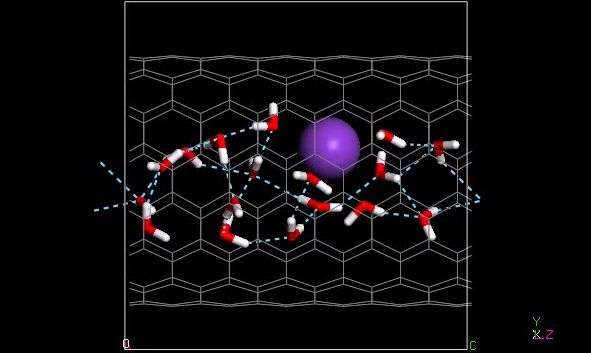August 25, 2015 report
Study reveals how nanochannels select potassium ions

(Phys.org)—One of the mysteries in biology is how cells can selectively diffuse potassium across a membrane. Biological systems rely on a delicate balance between these potassium and sodium ion concentrations in the surrounding environment and within the cell. Researchers, such as Dr. Bing Gong and his research group in SUNY Buffalo, have tried to solve this riddle by making synthetic ion channels that are selective for potassium.
To that end, Hui Li, Joseph S. Francisco, and Xiao Cheng Zeng from Chinese Academy of Sciences and from the University of Nebraska in Lincoln have elucidated some of the mystery behind ion selectivity using molecular modeling of these synthetic ion channels made of rigid macrocycles as well as channels made of carbon nanotubes. They used ab initio molecular dynamics simulations to investigate solvation structures, energetics, and dynamic properties of aqua Na+ and K+ in synthetic organic nanopores (SONP) and various sizes of single-walled carbon nanotubes (CNTs). Their work is published in the Proceedings of the National Academy of Sciences.
Prior simulation studies with synthetic ion channels have focused predominantly on Lennard-Jones potentials and Columbic effects. This is a reasonable area to investigate since researchers are trying to discern ion selectivity. These investigations pointed to the channel radius as the predominant factor for potassium selectivity. However, Li, et al. wanted to look at computations at the quantum-mechanical level to better understand water molecule interactions within a confined environment.
To investigate this, they used two systems: a synthetic organic nanopore, which is comprised of macrocycles that form a rigid hydrophobic pore, and various single-walled carbon nanotubes. Macrocycles are large ring structures whose donor atoms will coordinate to ions. Often macrocycles are selective for particular ions. However, because of the dangling donor atoms, the interior of the channel is molecularly rugged. This may affect the flow of water through the channel. They used carbon nanotubes were as a comparison because they can vary the opening size of the nanotube and the interior of the nanotube is relatively smooth and hydrophobic, matching certain properties of biological ion channels.
Li, et al. investigated three broad areas using ab initio molecular dynamics studies. They first investigated the hydration shell. Sodium and potassium ions attract the oxygen atom in water molecules. The water molecules surround the ions forming a "hydration shell." The radius of the hydration shell, the number of waters molecules coordinated to the ion, and the orientation of the water molecules around the ion all provide molecular level information that may give clues as to how the ion channels can distinguish between two similar ions. Their studies showed that the sodium ion hydration shell is more structured and robust than the potassium hydration shell.
The second area they investigated was the dynamic properties of the ion channels. In particular, Li, et al. looked at the lifetime of the ion-water bonds to determine the stability of the first hydration shell. They found that in bulk water and in all sizes of CNTs, the average lifetime of the Na+-water bonds were longer, and therefore more stable, than the K+-water bonds. Additionally, they found that confining any of the hydrated ions to a subnanometer-sized channel served to stabilize the bonds compared to bulk water.
Diffusion studies also showed that confinement to a CNT increased the diffusion rate compared to bulk water. Notably, diffusion through SONP was hindered compared to the CNTs because of its rugged interior surface.
The third area of investigation was in energetics. This is the key area that drives ionic selection. In general, because the sodium ion's first hydration shell is particularly robust compared to the potassium ion' shell, it would require more work to move the sodium ion from bulk water to the ion channel. Therefore, nanochannels with radii between 3.0 and 4.0 Å will selectively favor potassium. Of the particular systems tested, (8, 8) CNT with a radius of 3.7 Å, had the highest selectivity value for potassium ions.
This research helps solve some of the mystery behind potassium ion selectivity in biological systems. It also provides evidence that (8, 8) CNTs are the best synthetic nanochannels for investigating potassium ion selectivity.
More information: "Unraveling the mechanism of selective ion transport in hydrophobic subnanometer channels" PNAS, DOI: 10.1073/pnas.1513718112
Abstract
Recently reported synthetic organic nanopore (SONP) can mimic a key feature of natural ion channels, i.e., selective ion transport. However, the physical mechanism underlying the K+/Na+ selectivity for the SONPs is dramatically different from that of natural ion channels. To achieve a better understanding of the selective ion transport in hydrophobic subnanometer channels in general and SONPs in particular, we perform a series of ab initio molecular dynamics simulations to investigate the diffusivity of aqua Na+ and K+ ions in two prototype hydrophobic nanochannels: (i) an SONP with radius of 3.2 Å, and (ii) single-walled carbon nanotubes (CNTs) with radii of 3–5 Å (these radii are comparable to those of the biological potassium K+ channels). We find that the hydration shell of aqua Na+ ion is smaller than that of aqua K+ ion but notably more structured and less yielding. The aqua ions do not lower the diffusivity of water molecules in CNTs, but in SONP the diffusivity of aqua ions (Na+ in particular) is strongly suppressed due to the rugged inner surface. Moreover, the aqua Na+ ion requires higher formation energy than aqua K+ ion in the hydrophobic nanochannels. As such, we find that the ion (K+ vs. Na+) selectivity of the (8, 8) CNT is ∼20× higher than that of SONP. Hence, the (8, 8) CNT is likely the most efficient artificial K+ channel due in part to its special interior environment in which Na+ can be fully solvated, whereas K+ cannot. This work provides deeper insights into the physical chemistry behind selective ion transport in nanochannels.
Journal information: Proceedings of the National Academy of Sciences
© 2015 Phys.org




















